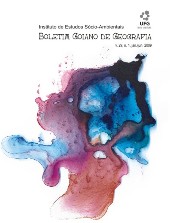CITY OF GOIÁS: THE SMELL OF WATER, THE FRAGANCE, AND THE HALLELUJAHS (1880-1899)
DOI:
https://doi.org/10.5216/bgg.v29i1.7305Abstract
This study focuses on the festive cycle Carnival-Lent-Easter in the City of Goiás, during the late nineteenth century. At that moment that, the administrative functions were centralized in the Province of Goyaz (the actual State of Goiás) and were sustained by an agrarian society, as the rural resources became its economic basis after the end of the mining cycle. Despite the importance of these resources, which placed the country side as the economic core area, the city imposed itself as the administrative center, cultural and demographic center. Because of the exploitation of gold, an urban center of colonial houses, with the
vilaboense population set on the banks of the Rio Vermelho, had been created. This was the urban festival, moments of effervescence in which the landscape received sounds, smells, colors, movements, etc. Since the dynamics of the Goiás economy was agrarian, the “farm” and “city” were the dominant elements in the folias and processions, or “festivals of the Church”, especially in the case studied, the celebrations of Lent and Easter.
Key-words: Folk celebrations. Carnival. City of Goiás. Lent.
Downloads
Downloads
Published
How to Cite
Issue
Section
License
Authors will not receive any payment for publishing their work in Boletim Goiano de Geografia. Therefore, they must grant all rights to the journal. However, they are entirely and exclusively responsible for the published contents, and editors are free to make corrections or adjustments to texts in conformity with publication guidelines.







